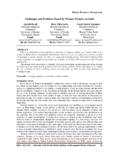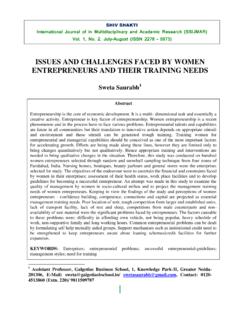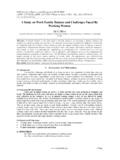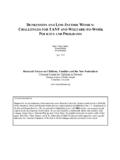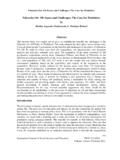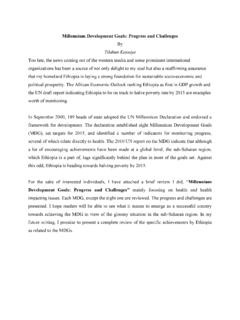Transcription of PUBLIC SECTOR – AN EMPLOYER OF CHOICE? REPORT ON …
1 1 PUBLIC SECTOR AN EMPLOYER OF CHOICE? REPORT ON THE competitive PUBLIC EMPLOYER PROJECTBYKIRSI IJ L 1 secondment to the OECD PUBLIC Management REPORT is based on the Expert Meeting on the competitive PUBLIC EMPLOYER project , held in Paris on 5 6 April 2001. The meeting included presentations of country-specific case studies, prepared by experts ofthe participating OECD Member countries. The purpose of the project was to support the efforts ofgovernments to enhance the competitiveness of PUBLIC employment in the labour market and to improveprofessionalism in the PUBLIC service.
2 The selected case studies of the project are published as separatechapters of this REPORT was prepared by Kirsi ij l of the OECD PUBLIC Management Service who would like to thankthe OECD countries that participated in the project and especially the authors of the case OF a competitive PUBLIC EMPLOYER project ? .. or challenges faced by the PUBLIC EMPLOYER with respect to problems in recruiting and/or retention .. will appear in a few years skills shortage .. underlying the identified strategies have been adopted? .. 12 Vision: PUBLIC service as an EMPLOYER of choice.
3 Trust in government and improving the image of the PUBLIC SECTOR .. 13 Conducting surveys .. 13 Improving the image of the PUBLIC SECTOR .. 14 Evaluation and monitoring Human Resource Management (HRM) systems .. 16 Development of management and development and career planning .. 17 Increasing mobility .. 17 Promoting equal opportunities between genders in PUBLIC organisations .. 18 How to recruit the best individuals and how to improve the recruitment 20 How to retain high quality staff in the PUBLIC SECTOR .. 21 Job better working 22 Wage policy, performance-based wage systems.
4 22 Creating and marketing incentives other than professionalism in the PUBLIC service .. 24 Staff development, training .. 24 Programmes to acquire lacking skills or competencies .. in implementing strategies .. 28 Some questions .. 28 What are the conclusions so far? .. REPORT summarises the material presented at the PUMA s expert meeting on the competitive PublicEmployer in 2001. It provides an overview of 11 selected Member countries work in the area ofenhancing the competitiveness of PUBLIC employers and solving critical skill shortages. This synthesis isbased on 11 country reports, an expert meeting, country answers on main points of competitive publicemployer strategies and PUMA s PUBLIC SECTOR Pay and Employment database.
5 Country reports areincluded as separate chapters in the purpose of the project is to support the efforts of governments to enhance the competitiveness ofpublic employment in the labour market and to improve professionalism in the PUBLIC service. The aim isto raise awareness of this issue and to help Member countries to deal with project on competitive PUBLIC EmployerThe competitive PUBLIC EMPLOYER project was discussed, and its importance to OECD work confirmed, at the HumanResources Management Working Party meeting in June 2000. It was subsequently launched in February 2001 with acall for country reports on the subject.
6 The project contributes to PUMA s work on Enhancing PUBLIC expert meeting was held at OECD Headquarters, Paris, on 5-6 April 2001, with representatives from 18 OECDM ember countries. Country reports were presented by Austria, Canada, Denmark, Germany, Korea, Italy, Norway,Poland, and Sweden. In addition, country studies were provided by Portugal and Spain. Other countries participatingin this conference included Belgium, Finland, France, Hungary, Iceland, Luxembourg, Mexico and Patricia W. Ingraham from Syracuse University, United States, participated in this meeting as a competitive PUBLIC EMPLOYER project ?
7 In the next 10 years, many OECD Member countries will be forced to hire a remarkable number of newemployees to replace current employees as they reach retirement age. Restructuring of governmentfunctions, privatisation and cuts in personnel spending have, in many countries, already led to decreasednumbers of PUBLIC employees. However, while the number of PUBLIC employees is not increasing, a specialchallenge for the PUBLIC SECTOR will be how to attract well-educated personnel. Figure 1 below illustrates theemployee situation in Member of entrants and leavers (1990-1999)0%1%2%3%4%5%6%199019911992199 3199419951996199719981999 EntrantsLeaversSource:OECD PUBLIC Management Service, 2001.
8 Copyright OECD 2001. All rights 1 shows the trends in annual ratio of entrants to leavers over total PUBLIC employment in the ratio for each year calculated is the arithmetic mean of the ratios of surveyed This indicatoris designed to provide cross-country trends of turnover rate of PUBLIC employment rather than weighted forthe OECD as a whole. The ratio of leavers across these countries has been increasing for the past 10 changes like downsizing and privatisation of PUBLIC SECTOR functions have affected this ratio of entrants to the PUBLIC SECTOR has been relatively stable for the same period.
9 From 1996, thenumber of leavers has been greater than the number of entrants. This trend will raise issues for thecompetitiveness of the PUBLIC SECTOR as an OECD Member countries are currently searching for strategies and policies on how to retain andenhance the professional quality of their PUBLIC service. If governments do not succeed in enhancing thecompetitiveness of the PUBLIC EMPLOYER in the labour market, the possibilities of recruiting highly qualifiedpersonnel to PUBLIC organisations will diminish dramatically. Additionally, the risk of an increasingoutflow from the strategic tasks of the PUBLIC service to more attractive private employment is a threat tothe PUBLIC SECTOR .
10 These trends present real challenges for governments in the starting point for the project on competitive PUBLIC EMPLOYER was the PUMA Human ResourceManagement Working (HRM) Party meeting in July 2000. Prior to that meeting, the Secretariat collecteddata regarding OECD Member country strategies to enhance the competitiveness of the PUBLIC employerand to cope with critical skills shortage. The results of the survey are shown in Box 2. selected OECD Member countries have been used for the Member country strategies to enhance the competitiveness of the PUBLIC EMPLOYER (2000)Australia Flexible salary scales.










